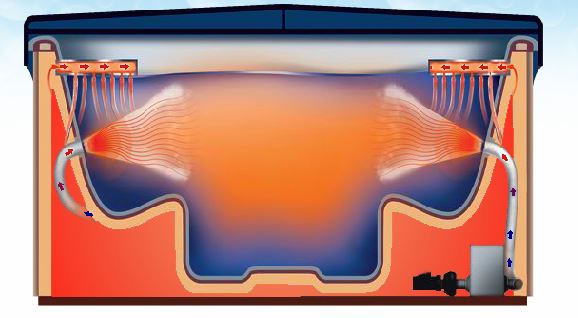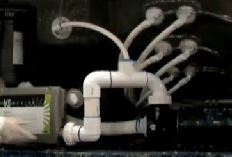It is that time of year again when spring has arrived and that spot in the backyard would be perfect for a hot tub.
There are many barriers to buying the right hot tub, and there are so many different manufacturers and brands that sifting through all of the sales nonsense can be time consuming and even misleading.
There are several ways of insulating a hot tub. Here is a review of a few of them.
 Barrier Insulation
Barrier Insulation
This is one of the most popular insulation methods. It involves insulating the inside perimeter of the spa cabinet and sometimes the floor while keeping the inner cabinet an air barrier which not only acts as an insulator but also allows the transfer of heat from pumps and equipment back to the plumbing of the spa.
In contrast to fully foamed spas, this type does not require an external vent or fan to exhaust out trapped heat to avoid pumps from burning up which allows costly heat to escape, so most of the heat generated by the equipment stays trapped in the cabinet.
The type of insulation around the inner perimeter of the cabinet may be a thin coat of foam spray (which doesn’t look so great but seems to work) and flat panel boards made of polystyrene in various thicknesses and densities.
These boards look clean when installed and also provide the desired insulation effect. The thicker the board and higher the foam density, the better the insulating property of them. Some manufacturers offer an option to double up the thickness of the boards and add insulation to the spa floor as well.
Another type of barrier insulation is the reflective foil barrier which reflects heat back into the spa while providing another layer of insulation around the interior of the cabinet and sometimes also on the floor.
Spray Foam Insulation
Spray foam insulation or full foam insulation means the entire cabinet is sprayed full of foam (or most of the cabinet). Sometimes the equipment bay is seperated off so insulation does not get into the pumps and equipment, but the areas around all of the jets and the shell are foamed with industrial spray foam. Sometimes this is visible from the bottom of the spa as well when the side is stood up on end. Other times a piece of hard plastic or other floor closes off the bottom.
No Insulation
The cheapest of spas will not have any insulation around the inside perimeter of the cabinet. In that case, hanging Roxul batts around the inside perimeter may do the trick.
The material in Roxul is also anti-rodent.
Spa Insulation
So with all of the different types of insulation, the most important of all seems to be neglected. The spa cover provides the most protection from heat escaping out the top of the spa. As heat rises, it will try to escape out any opening in the spa cabinet but especially out the top. A good hard cover is essential, especially in colder climates. The cover should also be tapered which means it is higher in the middle than on the sides in order for rain and melting snow and ice to run off. The bare minimum for a hard cover is a 3″-2″ tapered thickness. Better is 4″-2″ or 5″-3″ or even 5″-4″. Cover manufacturers also make a 6″-4″ cover, but then the cover becomes very bulky and a cover lifter becomes essential.
After getting a good cover, the next most important spa insulation element is a floating spa cover. These type of softer covers actually float on the surface of the water and provide another air barrier between the top of the floating spa cover and the underside of the exterior hard cover. This double cover system keeps heat from escaping from the water that is in the shell.
 A spa that only circulates 2-4 hours every 12 hours during filter cycles with otherwise have the warm water in the shell and as that water starts to cool, the spa electronics send a signal to the circulation pump to begin circulating (on 2 speed main pump circulation systems). For those with a dedicated circ pump, the water is in constant, although weaker, motion. The heater only comes on when the temperature falls a certain amount below the set temperature in order to maintain water temperature. The faster the spa water cools down on its own, the more the heater has to come on.
A spa that only circulates 2-4 hours every 12 hours during filter cycles with otherwise have the warm water in the shell and as that water starts to cool, the spa electronics send a signal to the circulation pump to begin circulating (on 2 speed main pump circulation systems). For those with a dedicated circ pump, the water is in constant, although weaker, motion. The heater only comes on when the temperature falls a certain amount below the set temperature in order to maintain water temperature. The faster the spa water cools down on its own, the more the heater has to come on.
Especially where the underside of the shell is insulated, the main way heat will escape from the spa is out the top, so do not read too much into full foaming or barrier insulation, because nobody publishes their actual electrical usage stats under similar conditions where one is markedly superior to the other. If it were, they would in this fiercely competitive industry.
It is important to note that lately, more and more manufacturers are indeed doing electrical consumption testing behind closed doors for their own internal purposes including the need to comply with recent Calfornia Department of Energy rules regarding all electrical appliances and particularly hot tubs. Legitimate manufacturers are thus assuring their spas meet or exceed the requirements set forth by the California DOE. That is good for consumers, because you don’t have to really question the insulation effectiveness of one brand of spa to another as long as each of them is made by a reputable manufacturer who has completed and passed this testing for the California DOE. The rest of the insulation debate is just smoke and mirrors.
Practical Concerns of Various Insulation Types
Well if the most important component to keeping hot tub electrical consumption down is the hard cover, then what are the possible side effects and cons to the various other insulation types? Simply put, fully foamed spas are a nightmare to repair in the case there should ever be a leak. Ask any service tech out there about the hours they will need to spend scraping a pile of foam out and even having to stand the spa upright to access things from the bottom. This is a huge negative for that type of insulation. You must then really buy into the fact that you will save a bundle on electricity if you fully foam the spa, but this debate has been going on for over 20 years and the full foamers have yet to produce unbiased test results that prove it. If it were the undisputed superior way of building spas, everybody would be doing it that way.
 On the contrary, the foam panels or other cabinet insulation around the perimeter may be brittle and break if a cheap type of panel is used. The higher pound foam panels are more durable, so there is somewhat of a difference between 1/4 inch 1 pound foam panels and 1/2 inch or 3/4 inch or more 1 1/2 pound or even 2 pound foam panels. Any additional insulation is just helpful such as the reflective barrier type of rolled insulation.
On the contrary, the foam panels or other cabinet insulation around the perimeter may be brittle and break if a cheap type of panel is used. The higher pound foam panels are more durable, so there is somewhat of a difference between 1/4 inch 1 pound foam panels and 1/2 inch or 3/4 inch or more 1 1/2 pound or even 2 pound foam panels. Any additional insulation is just helpful such as the reflective barrier type of rolled insulation.
But the kicker is, if one is really convinced to need more perimeter insulation around the inside of the cabinet, then just do what H2O spas tells their customers among other brands, and just hand some Roxul insulation available at Home Depot and other stores, around the inside perimeter and problem solved. (If you believe there was a problem to begin with for which there is not much empirical evidence either way).
Fully foaming or stuffing the spa cabinet with too much insulation has diminishing returns. The cons of this are that the foam may actually move as it contracts and expands, moving pipes and joints along for the ride and causing leak issues where there otherwise would not have been any. Too much foam and no air in the cabinet means somehow the spa will need to pull more unheated air from outside, another diminishing return. And finally, especially in summer months, if the pumps cannot breathe a bit, they may overheat faster and shut down. Then there is the rodent problem, and rodents love burrowing and nesting – but they won’t nest in Roxul. Somehow, the air barrier solution seems like a cleaner solution as you can access any spa component or the backside of lights, jets and other equipment, hoses, manifolds as needed. The fully foamed solution does actually provide more structural support to the spa shell though, but spas built with sturdy metal frames or a thicker, higher grade of acrylic do just fine without foam support. Many spas actually use cross members and bracing to support key parts of the spa shell anyways.
So as the smoke drifts away and the razzle dazzle of the showroom sales dance subsides, it does not seem, at least energy savings wise, that the full foam debate vs. the closed air barrier debate really matters all that much. Just get a really good cover. You can always add a row of Roxul around the inside if it will make you sleep better, your electric meter probably won’t tell much of a difference.
